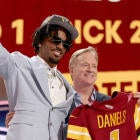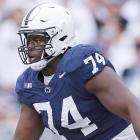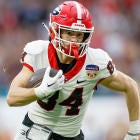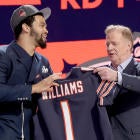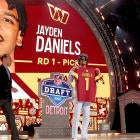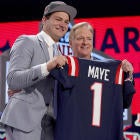Six days after Deflategate took over America, Patriots coach and polymath Bill Belichick met with the media Saturday to share his findings from a week-long science experiment. It was something so let's get to it.
We believe Belichick
Bill Belichick is telling the truth. We believe that after Saturday's 30-minute press conference explaining the minutiae of PSIs, atmospheric and climatic conditions, all as it relates to footballs. Of course, we believed Belichick on Thursday, when he made his first public remarks about the silliness that is Deflategate, when he was emotional (at least by Belichick-ian standards), contrite and honest-seeming about what he did and didn't know regarding the most manufactured scandal we can remember.
(You can subscribe to the Eye on Football Podcast via iTunes right here.)
So what did we learn from Saturday's press conference? For starters, Belichick is smart. Not because he probably wore a white lab coat while he conducted a week's worth of experiments, or that he sounded like he knew what he was talking about when he explained the findings to the media (imagine Joe Philbin trying to lead that discussion). But because Deflategate is dead. Belichick was explicit, telling the media that "this is the end of this subject for me." And by extension, his team.
And for that alone, the man deserves an award. Our long, stupid, pointless nightmare is over. (At least until the league renders a ruling sometime after the Super Bowl.)
Questions remain, however ...
Namely: What was Tom Brady's role in all this? The conspiracy theorists maintain that, while the coach likely had no idea what was going on, the quarterback almost certainly did. He's the guy handling the football on every play, and his preferences would take precedence. Belichick didn't address that, but we'll repeat what we've been saying all week: At the end of the day, it's still a football. It's not like Brady was using a Nerf Vortex, throwing frozen ropes 80 yards downfield. There was also no explanation for why the Patriots' footballs were under-inflated in the AFC Championship Game while the Colts' footballs were within the limits set forth in the rule book. Is it curious? Yeah, sure. But we don't think it has risen to the level of national-security issue, which is how some people are treating it.
Belichick has jokes
Finally, we were reminded that Belichick is hilarious, even more so when it's unintentional. We were treated to plenty of that Saturday.
"I'm embarrassed to talk about the amount of time I've put into this relative to the other important challenge in front of us," he said late in the press conference. "I'm not a scientist, I'm not an expert in footballs, I'm not an expert in football measurements, I'm just telling you what I know. I would not say that I'm Mona Lisa Vito of the football world as she was in the car expertise area."
That's right, Bill's dropping My Cousin Vinny references.
“You can't make those marks without positraction” pic.twitter.com/ImqcQ9MGH2
— Will Brinson (@WillBrinson) January 24, 2015
Then, when discussing the science of rubbing up the, sigh, footballs to get the right texture, Belichick offered this qualification:
Here are the highlights from the rest of his press conference:
Belichick opens the presser with some background on the past six days
"I spent a significant amount of time this past week learning as much as I could learn about bladders, air gauges, stitches, pressure, game-day ball preparation, rubdowns and so forth. Trying to be as helpful as I can here and share with you what I've learned. Having coached for 40 years in the National Football League, played for several years, growing up in a football family, being around this game my entire life, it's clear that I don't know very much about this area.
"Over the last few days, I've learned a lot more than I ever knew -- like exponentially more. I feel like this is important because there have been questions raised and I believe now 100 percent that I have personally -- and we as an organization have absolutely followed every rule to the letter. I feel that on behalf of everyone in the organization -- everyone that's involved in this organization -- I need to say something.
"I've talked to and gathered a lot of information from members of our staff. I have talked to other people familiar with the subject in other organizations. And we have performed an internal study of the process and I think there is certainly other things that I can do, and there is other research that can be done. But I say at this time that I definitely have enough information to share with you.
"Based on the events of today, I feel like now's the time to do it instead of wait."
Belichick goes into details about the science experiment
"First of all, let me start with the process. As Tom [Brady] explained on Thursday, the most important part of the football for the quarterback is the feel for the ball. ... The exterior feel of the ball is not only critical but it's easily identifiable. ... We prepare our balls over time and we use them in practice. And that preparation process continues right up until the balls are given to the officials prior to the game. ... I would say within that process, I've handled dozens of balls over the past week. The texture of the balls is very easy to identify. The pressure of the footballs is a whole different story. It's much more difficult to feel or identify.
"So the focus of our pregame preparation for the footballs is based on texture and feel. And I think Tom went into that extensively on Thursday and he obviously could go through it a lot better than I can because he's the one that touched them. But that's the heart of the process."

Interesting Finding No. 1: PSI increased due to 'prepration process'
"We simulated a game-day situation, in terms of the preparation of the footballs, and where the footballs were at various points in time during the day or night. ... I would say that our preparation process for the footballs is what we do -- I can't speak for anybody else -- and that process raises the PSI approximately one pound. That process of creating a tackiness, a texture -- a right feel, whatever that feel is, whatever that feel is. It's a sensation for the quarterback. What's the right feel -- that process elevates the PSI one pound, based on what our study showed. Which was multiple balls, multiple examples in the process, as we would do for a game."
What PSI did the officials set the footballs for the AFC Championship Game?
"When the balls are delivered to the officials' locker room, the officials were asked to inflate them to 12.5 PSI. What exactly they did, I don't know. But for the purposes of our study, that's what we did. We set them at 12.5. That's at the discretion of the official, though. Regardless of what we ask for, it's the official's discretion to put them where he wants.
"Again, that's done in a controlled climate. The footballs are prepared in our locker room. They're delivered to the officials' locker room, which is a controlled environment. ... When the footballs go out onto the field in the game conditions, whatever those conditions are -- whether it's hot and humid, cold and damp, cold and dry, whatever it is -- that's where the footballs are played with. And that's where the measurements would be different -- possibly different -- than what they are in a controlled environment. And that's what we found."
Interesting Finding No. 2: A football's PSI adjusts to the 'climatic conditions'
"We found that once the balls were on the field over an extended period of time -- in other words, they adjusted to the climatic conditions and also the fact that the balls reached an equilibrium without the rubbing process that after that had run its course, and the footballs had reached an equilibrium, they were down approximately 1.5 pounds per square inch."
Interesting Finding No. 3: A football's PSI is dynamic, based on the weather
"When we brought the footballs back in after that process and re-tested them in a controlled environment, then those measurements rose one-half pound per square inch. So the net of 1.5 and 0.5 is approximately one pound per square inch.
"Now, we all know that air pressure is a function of the atmospheric conditions. So if there's activity in the ball relative to the rubbing process, I think that explains why, when we gave them to the officials and the officials put them at 12.5 -- if that's in fact what they did -- that once the ball reached its equilibrium state, it was probably closer to 11.5 (PSI). We can't speak specifically to what happened because we have no way of touching the footballs ... except when we play with them in the game."
Belichick likes to use anologies, too
"It's similar to the concept of when you get in your car and the light comes on and it says 'low tire pressure' because the car's been sitting in the driveway outside overnight. And you start it up and you start driving it and the light goes off, it's a similar concept to that. So the atmospheric conditions as well as the true equilibrium of the ball is critical to the measurement."
'How a cow becomes an NFL football for the Patriots' needs the Schoolhouse Rock treatment
"At no time, were any of our footballs prepared anywhere other than the locker room or in an area very close to that. Never in a heated room or a heated condition. That has absolutely never taken place to anyone's knowledge or anyone's recollection. That ... didn't happen.
"When you measure a football, there are a number of different issues that come up. No. 1: Gauges. there are multiple types of gauges and the accuracy of one gauge to another -- there's variance there. We're talking about air pressure. Clearly, all footballs are different. ..."
Interesting Finding No. 4: Footballs do not get measured during the game
"Footballs do not get measured during the game. We have no way of knowing, until we went through this exercise, that this has really taken place. When we hand the balls to the officials, they put them at, let's say, 12.5, the air pressure from that point until the end of the game we have no knowledge of. And honestly, it's never been a concern. What has been a concern is the texture of the ball, and that's what Tom hit hard on Thursday."
Interesting Finding No. 5: Patriots QBs are bad at detecting under-inflated balls
"We had our quarterbacks look at a number of footballs and they were unable to differentiate a one-pound per-square-inch difference in those footballs. They were unable to do it. On a two-pound differential, there was some degree of differentiation but certainly not a consistent one. A couple ones they could pick out, but they were wrong in some of the other ones they had. You're welcome to do that yourself. I can tell from all the footballs I've handled over the last week, I can't tell the difference if there's a one-pound or a half-a-pound difference in any of the footballs."
Belichick quietly channels Rodney Harrison, plays the 'Us against the world!' card
"Again, anyone who has seen us practice, knows that we make it harder, not easier, to handle the ball. And our players train in conditions [that are not] recommended we not drive in. That's what they do. They're a physically and mentally tough team that works hard, that trains hard, that prepares hard, and have met every challenge I put in front of them. ... This team was the best team in the AFC in the regular season, we won two games in the playoffs against two good footballs teams, best team in the postseason. And that's what this team is. And I know that because I've been with them every day. And I'm proud of this team. ...
"And at no time was there any intent whatsoever to try to compromise the integrity of the game or gain an advantage. Quite the opposite. We feel like we follow the rules of the game to the letter in our preparations, in our procedures and in the way we handle every game that we competitively play in as it relates to this matter. We try to do everything right. We try to err on the side of caution. It's been that way for many years. Anything that's close, we stay as far away from the line as we can. In this case, I can say that we are, as far as I know and everything I can do, we did everything as right as we can do it."
The podcast where @willbrinson & I cast Game of Balls: https://t.co/aHoHyqvtIy | subscribe: https://t.co/8QXfR4K1mR pic.twitter.com/9mgJjvNzNP
— ryan wilson (@ryanwilson_07) January 21, 2015
We're still convinced that Belichick is the NFL's version of Tywin Lannister. (This is a joke.)
And with that, Belichick's done talking about it
"We welcome the league's investigation into this matter. I think there are a number of things that need to be looked into on a number of levels, but that's not for this conversation. I'm sure it'll be taken up at another point in time. And this is the end of this subject for me for a long time, OK. We have a huge game, a huge challenge for our football team, and that's where that focus is going to go. I've spent more than enough time on this and I'm happy to share this information with you to try to tell you some of the things I have learned over the last week."
Yes, somebody asked about Spygate
"Look, that's a whole other discussion. The guy's giving signals out in front of 80,000 people, OK? So we filmed him taking signals out in front of 80,000 people, like there were a lot of other teams doing at that time too. But forget about that. If we were wrong, we were disciplined about that. ... We never did it again, we're never going to do it again."
Finally...
We would love for this to happen, even if it's not true.
Never got why Deflategate was a scandal but part of me hopes Belichick wears this next Sunday. http://t.co/7GmrN7IZ4M pic.twitter.com/ApIwMUVyUb
— ryan wilson (@ryanwilson_07) January 24, 2015













